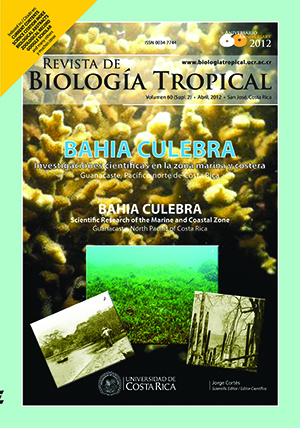Abstract
Caulerpa sertularioides has been spreading in Bahía Culebra, a seasonal upwelling bay in the north Pacific of Costa Rica, since 2001. The survey was carried out from December 2003 to March 2005, in several locations around Bahía Culebra, located inside the Gulf of Papagayo. This study investigated spatial and temporal patterns, percent coverage, monthly growth rate, reproductive adaptations, and morphological variations of frond length and stolon diameter of Caulerpa sertularioides, at different environmental physical and chemical factors at the bay. The alga extended to depths of 23 m on a variety of substrates. The stolons extended quickly, with a maximum growth rate of 31.2 cm month-1. This alga grows mainly by fragmentation of its fronds and stolons; nevertheless it can also reproduce sexually by releasing gametes in the water column. These two modes of spreading promote the adaptation of this opportunistic species to environmental, chemical, and physical changes at this bay. At the same time the alga showed variations in the length of its fronds and stolons, adapting to conditions such as depth and season. Average percent cover and frond density increased during the dry season when the upwelling of nutrients and cold water occurs. In the rainy season the average percent cover and frond density decreased; however there was a peak in September, when high precipitation resulted in runoff into the bay of nutrient-rich waters. The morphological and physiological plasticity of C. sertularioides, in synergy with its predominant clonal propagation and sexual reproduction provided this species with a great adaptability to changes in temperature and nutrient concentration at Bahía Culebra.Comments
Downloads
Download data is not yet available.






